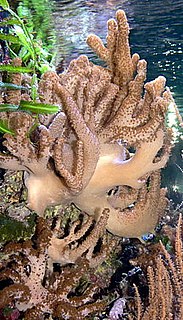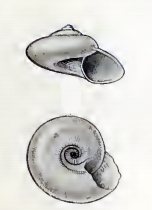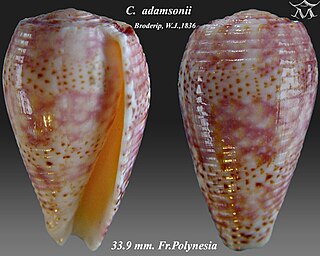
Isopoda is an order of crustaceans that includes woodlice and their relatives. Isopods live in the sea, in fresh water, or on land. All have rigid, segmented exoskeletons, two pairs of antennae, seven pairs of jointed limbs on the thorax, and five pairs of branching appendages on the abdomen that are used in respiration. Females brood their young in a pouch under their thorax.

Tube-dwelling anemones or ceriantharians look very similar to sea anemones but belong to an entirely different subclass of anthozoans. They are solitary, living buried in soft sediments. Tube anemones live inside and can withdraw into tubes, which are composed of a fibrous material made from secreted mucus and threads of nematocyst-like organelles known as ptychocysts. Within the tubes of these ceriantharians, more than one polyp is present, which is an exceptional trait because species that create tube systems usually contain only one polyp per tube. Ceriantharians were formerly classified in the taxon Ceriantipatharia along with the black corals but have since been moved to their own subclass, Ceriantharia.

Alcyonacea, or soft corals, are an order of corals. In addition to the fleshy soft corals, the order Alcyonacea now contains all species previously known as "gorgonian corals", that produce a more or less hard skeleton, though quite different from "true" corals (Scleractinia). These can be found in suborders Holaxonia, Scleraxonia, and Stolonifera. They are sessile colonial cnidarians that are found throughout the oceans of the world, especially in the deep sea, polar waters, tropics and subtropics. Common names for subsets of this order are sea fans and sea whips; others are similar to the sea pens of related order Pennatulacea. Individual tiny polyps form colonies that are normally erect, flattened, branching, and reminiscent of a fan. Others may be whiplike, bushy, or even encrusting. A colony can be several feet high and across, but only a few inches thick. They may be brightly coloured, often purple, red, or yellow. Photosynthetic gorgonians can be successfully kept in captive aquaria.

Heterodonta is a taxonomic subclass of saltwater clams, marine bivalve molluscs. This subclass includes the edible clams, the cockles and the Venus clams.

Psychotria is a genus of flowering plants in the family Rubiaceae. It contains 1,582 species and is therefore one of the largest genera of flowering plants. The genus has a pantropical distribution and members of the genus are small understorey trees in tropical forests. Some species are endangered or facing extinction due to deforestation, especially species of central Africa and the Pacific.
Myrsine adamsonii is a species of plant in the family Primulaceae. It is endemic to French Polynesia. The epithet adamsonii commemorates Robert Stephen Adamson.
Psychotria adamsonii is a species of plant in the family Rubiaceae. It is endemic to French Polynesia. The epithet adamsonii commemorates Robert Stephen Adamson.

Myrsine is a genus of flowering plants in the family Primulaceae. It was formerly placed in the family Myrsinaceae before this was merged into the Primulaceae. It is found nearly worldwide, primarily in tropical and subtropical areas. It contains about 200 species, including several notable radiations, such as the matipo of New Zealand and the kōlea of Hawaiʻi. In the United States, members of this genus are known as colicwood. Some species, especially M. africana, are grown as ornamental shrubs.

Solariellidae is a family of small sea snails, marine gastropod mollusks in the superfamily Trochoidea.

Freshwater snails are gastropod mollusks which live in fresh water. There are many different families. They are found throughout the world in various habitats, ranging from ephemeral pools to the largest lakes, and from small seeps and springs to major rivers. The great majority of freshwater gastropods have a shell, with very few exceptions. Some groups of snails that live in freshwater respire using gills, whereas other groups need to reach the surface to breathe air. In addition, some are amphibious and have both gills and a lung. Most feed on algae, but many are detritivores and some are filter feeders.
Pediculariinae is a subfamily of small to large predatory or parasitic sea snails, marine gastropod molluscs in the family Ovulidae and the superfamily Cypraeoidea, the cowries and the cowry allies. As of 2009, it comprises 48 described species of which 20 are regarded as valid by most scientists.

Artiofabula is a clade made up of the Suina and the Cetruminantia. The clade was found in molecular phylogenetic analyses and contradicted traditional relationships based on morphological analyses.

Conus adamsonii, common name the rhododendron cone, is a species of sea snail, a marine gastropod mollusk in the family Conidae, the cone snails and their allies.
Pseudocypraea alexhuberti is a species of sea snail, a marine gastropod mollusk in the family Ovulidae, one of the families of cowry allies.
Pseudocypraea exquisita is a species of sea snail, a marine gastropod mollusk in the family Ovulidae, one of the families of cowry allies.

Pseudocypraea is a genus of sea snails, marine gastropod mollusks in the family Ovulidae, one of the families of cowry allies.
Lachnagrostis is a genus of African, Australian, Pacific Island, and South American plants in the grass family. They are often treated as members of genus Agrostis.

Textilia is a subgenus of sea snails, marine gastropod mollusks in the genus Conus, family Conidae, the cone snails and their allies.

Terrestrial molluscs or land molluscs (mollusks) are an ecological group that includes all molluscs that live on land in contrast to freshwater and marine molluscs.













